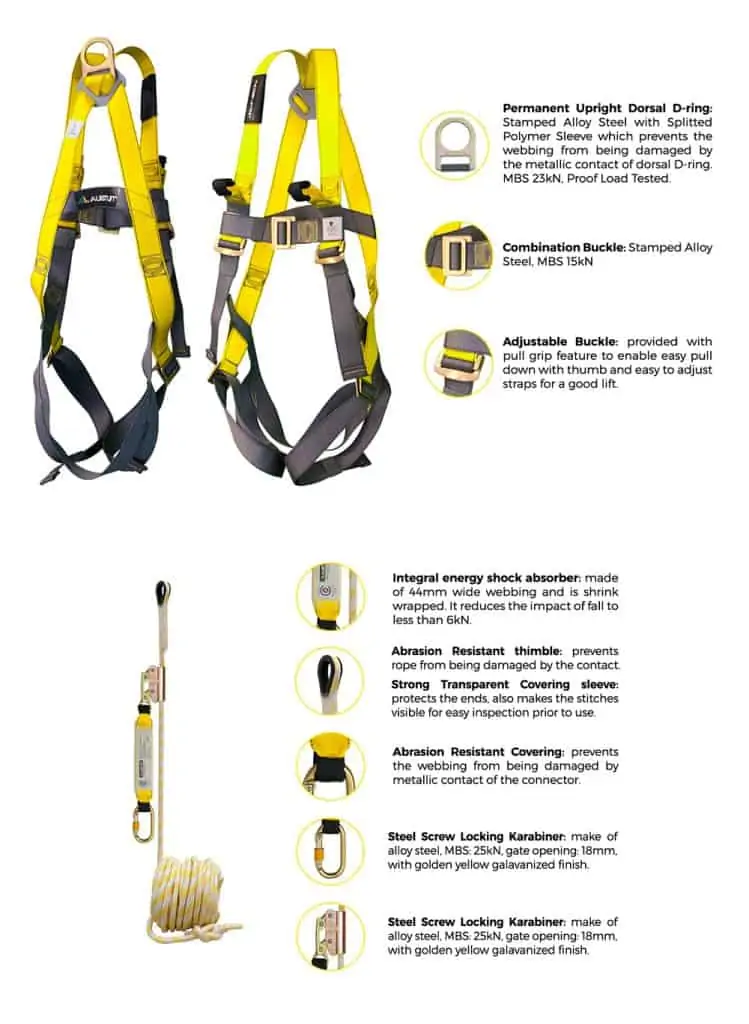All work at height has inherent hazards. Roof cleaning, construction, and repair are some of the most dangerous jobs on this list. Falling is the most common type of injury when working on flat roofs. When climbing on the roof, you must be as safe as possible. You must use a safety roof harness kit every time you work at a height. The roof harness system is fundamental but will only work well if used properly. You need to understand how a particular harness works, how to recognize when worn out, and what other gear to use if you want to get the most out of your harness.

That’s why we bring you the ultimate guide to working on a roof with utmost safety. If you want to hire or purchase roof harness kits, remember to check out the Conveying and Hoisting Solutions collection. It contains some of the best safety harnesses for various purposes, all within an affordable range.
Now, let’s start understanding how to work on roofs safely.
● Get Your Extension Ladder Ready
An extension ladder is your first requirement to climb to the roof. Stay away from power lines, and do not place ladders on doors. When getting off the ladder, put it out 1m higher than the gutter or roof. The ladder angle needs to be 4 in 1, i.e., every 4m while climbing out, every 1m out of the gutter. Always face the ladder, make three-point contact (both feet and one hand on the stile), and don’t reach out. Place a square of plywood under one foot on uneven ground to level the ladder’s base and attach a wire or rope to the stake to secure it. Secure the ladder top with a wire or rope. It prevents it from sliding sideways when climbing onto the roof.
Always do a thorough inspection of the ladder before climbing. Make sure it has a smooth surface but is not slippery. Wooden ladders can get worn out with some pricks coming out here and there. Make sure to check it as they can hurt your badly.
● Properly Fasten the Safety Roof Harness Kit
On low-slope roofs where legroom is not a problem and eaves are less than 12 feet off the ground, roof brackets and boards alone are safe to work on. It’s good. But for ultimate roof safety, especially on steep roofs and large jobs, invest in safety harnesses and ropes. Roof anchors should get firmly anchored to solid wood such as rafters, trusses, ridge beams, shingles, and plywood. Please follow the manufacturer’s instructions carefully, as models vary slightly. Inspect harnesses and lanyard seams for loose seams and webbing for wear.
● Do not reuse a dropped harness or lanyard.
● Inspect the rope for fraying. Adjust the webbing buckles for a snug fit.
● Place the roof anchor just above where you will be working on the roof.
● Do not work more than four feet from the side of the roof anchor.
● Reposition or add more anchors as needed.
● Work on Roofs Under Decent Weather Conditions
Often, a roof hazard comes out of one significant danger that often goes neglected – the weather. Weather is crucial in determining your overall success in working on the roof. It indicates your safety while you are working. Not only does raw weather cause slips and falls, but it can also interfere with proper roofing. So start with, you must never get on the roof on a rainy day. It makes the surface slippery and causes so many electrical dangers. Wet roofs also pose a greater risk of slips and falls. Take care, and always wait for ideal weather before starting any roofing work.
● Use An Adequate Fall Protection Method
Implementing a fall protection method is extremely necessary. In most cases, your safety roof harness kit is everything you may require for fall protection. However, using another way of fall protection in some projects is vital. You can use a personal fall arrest system (PFAS) or barricades and guardrails for passive fall protection. The Conveying and Hoisting Solutions include a wide range of PFAS, full-body harnesses, and roof harness kits. Make sure to hire or make a purchase before climbing up the ladder and starting your project.
● Use Electricity and Power Tools Properly
Some workers most at risk from electrical hazards are those working on rooftops or near power lines. Improper handling of electrical equipment can result in extensive electric shock, burns, fire, and death. To prevent accidents, perform regular electrical safety checks to identify and control possible sources of electrical shock. Power tools are essential for roof work. However, improper use of power tools at height can result in serious personal injury, slips, and falls. So you must know how to use the power tools before using them on a roof for your project.
Safety Inspection You Should Never Miss :
● Make sure the ladder is in order. Use a sturdy, wide wedge to support your legs if you can’t stand on firm, flat ground.
● Select good weather days. Avoid icy, rainy, and scorching heat.
● Do not work alone. You need someone to stabilize the ladder. If you slip, you need assistance to get off the ladder by asking for immediate help.
● Wear non-slip, closed-toe shoes – bare feet or strappy shoes are unsuitable. Soft-soled tennis shoes are the best option for working on the roof.
● If the roof is steep, more than 35 degrees, you should hire a professional.
Final Words
Many roof accidents are caused by tripping or falling from a height. It kills hundreds of people each year and causes many non-fatal severe injuries. So it’s necessary to have proper knowledge of roof safety. Always remember working on a lower roof and neglecting to wear a roof harness kit. You should ensure that your ladder, ropes, wires, anchors, and harness work successfully. You must ask the help of roofers in case your project requires professional assistance. Lastly, ensure to be well-hydrated while working on the roof because the heat can cause severe headaches and dizziness.



